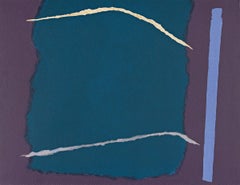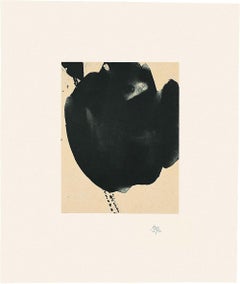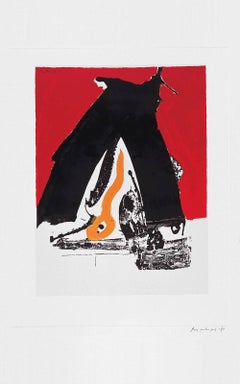Theodoros Stamos More Prints
American, 1922-1997
The Greek American artist, Theodoros Stamos, was born in 1922 in New York City into a family of Greek immigrants. He was a member of The Irascibles group which consisted of the first generation of the New York School and Abstract Expressionism. Members included Jimmy Ernst, Barnett Newman, James Brooks, Mark Rothko, Jackson Pollock, Clyfford Still, Robert Motherwell, Ad Reinhardt, and others.
Betty Parsons hosted a solo exhibition of Stamos work in 1943 when he was only 21 years old. In the years following, Parsons served as a vital mentor helping Stamos establish his position in the contemporary art world.
Stamos early works from the 1940’s incorporated organic motifs and earthy coloring. As a member of The Irascibles, Stamos was influenced by his fellow members and his technique began to shift towards a more expressionist style. His works became increasingly simplified in the subsequent years, tending towards greater abstraction. Areas of flat color contrast one another to create a sense of depth in his works.
Stamos taught at Black Mountain College in North Carolina, the Art Students League in New York, and the Cummington School of Fine Arts in Massachusetts. His art is owned by many major collections including The Phillips Collection in Washington, DC; Museum of Modern Art in New York, New York; and the Art Institute of Chicago in Chicago Illinois. He passed away in 1997 in Greece. to
2
Overall Width
to
Overall Height
to
2
12
666
450
234
166
2
2
2
2
2
Artist: Theodoros Stamos
Untitled (Infinity Field—Lefkada Series)
By Theodoros Stamos
Located in New York, NY
A very good impression of this color screenprint on white wove paper. Artist's proof, aside from the edition of 75. Signed and inscribed "color trial proof." Printed by Kelpra Studio...
Category
1970s Abstract Expressionist Theodoros Stamos More Prints
Materials
Color, Screen
Untitled (Infinity Field--Lefkada Series)
By Theodoros Stamos
Located in New York, NY
A very good impression of this color screenprint on white wove paper. Artist's proof, aside from the edition of 75. Signed and inscribed "A.P." in pencil by Stamos. Printed by Kelpra...
Category
1970s Abstract Expressionist Theodoros Stamos More Prints
Materials
Color, Screen
Related Items
Octavio Paz Suite: Nocturne VI
By Robert Motherwell
Located in London, GB
Lithograph and chine appliqué
64.5 x 54 cms (25 3/8 x 21 1/4 ins)
Edition 50
Paper: Arches paper; Japanese Gampi handmade paper
Other Collaborators: Image transferred from Mylar to...
Category
1980s Abstract Expressionist Theodoros Stamos More Prints
Materials
Handmade Paper, Color, Lithograph
The Basque Suite: Untitled
By Robert Motherwell
Located in London, GB
Edition of 150
104.1 x 71.7 cms (41 x 28 1/4 ins)
Category
1970s Abstract Expressionist Theodoros Stamos More Prints
Materials
Screen
Cleve Gray Abstract Expressionist color band - rare silkscreen signed & numbered
By Cleve Gray
Located in New York, NY
Cleve Gray
Untitled, 1970
Silkscreen
Boldly signed and numbered 32/100 in graphite pencil by Cleve Gray on the front
30 × 22 1/2 inches
Signed and numbered 32/100 by artist on the fr...
Category
1970s Abstract Expressionist Theodoros Stamos More Prints
Materials
Screen
Abstract Expressionist Lithograph for the Carnegie Museum of Art, Lt Ed. of 1000
By Joan Mitchell
Located in New York, NY
Joan Mitchell
Untitled Abstract Expressionist Print for the Carnegie Museum of Art, 1972
Lithograph on wove paper
15 × 22 inches
Limited Edition of 1000 (unnumbered)
Printer: Maeght...
Category
1970s Abstract Expressionist Theodoros Stamos More Prints
Materials
Lithograph
The Darker Palette print, Hand signed twice and inscribed by Helen Frankenthaler
By Helen Frankenthaler
Located in New York, NY
Helen Frankenthaler (after)
Frankenthaler: The Darker Palette (autographed and inscribed), 1998
Offset Lithograph print
42 × 35 in
hand signed "Frankenthaler" lower left; inscribed a...
Category
1990s Abstract Expressionist Theodoros Stamos More Prints
Materials
Offset, Lithograph
Deadpan Pink - Monoprint EV on Paper
Located in Soquel, CA
Deadpan Pink - Monoprint EV on Paper
Original transfer monotype painting by California artist Heather Speck (American, 20th C). Heavily textured in hues...
Category
1990s Abstract Expressionist Theodoros Stamos More Prints
Materials
Paper, Monotype
$1,080 Sale Price
20% Off
H 32 in W 26 in D 0.25 in
A Paintings Retrospective: vintage LACMA Museum poster depicting her 1963 work
By Helen Frankenthaler
Located in New York, NY
Helen Frankenthaler (after)
A Paintings Retrospective: vintage LACMA Museum poster, 1990
Offset lithograph museum poster
(Unsigned & Unnumbered)
37 × 25 inches
Unframed
This was printed in the artists lifetime - making it more collectible - on the occasion of the exhibition, "Helen Frankenthaler: A Paintings Retrospective from February to April, 1990 at the Los Angeles County Museum of Art (LACMA)
Print is published by Editions Limited Galleries, San Francisco for Los Angeles County Museum of Art (LACMA), LA, CA
The work depicted is Helen Frankenthaler, The Bay, 1963, acrylic on canvas, Detroit Institute of Arts, Michigan (Incidentally, this beautiful work is featured on the cover of the book Water and Art' by David Clarke.)
“What concerns me when I work is not whether a picture is a landscape… or whether somebody will see a sunset in it. What concerns me is, did I make a beautiful picture?” - - Helen Frankenthaler
This is Frankenthaler's first silkscreen, produced for the portfolio New York Ten, which includes works by other New York-based artists at the time such as Roy Lichtenstein, Jim Dine, Tom Wesselmann and Claes Oldenburg. (She created her first lithograph in 1961)
Other examples of this edition are found in the permanent collections of the Museum of Modern Art, MOCA Chicago, the Metropolitan Museum, the Philadelphia Museum, the Art Institute of Chicago, and numerous regional museums and institutions in the United States and worldwide.
Helen Frankenthaler, A Brief Biography
Helen Frankenthaler (1928-2011), whose career spanned six decades, has long been recognized as one of the great American artists of the twentieth century. She was eminent among the second generation of postwar American abstract painters and is widely credited for playing a pivotal role in the transition from Abstract Expressionism to Color Field painting. Through her invention of the soak-stain technique, she expanded the possibilities of abstract painting, while at times referencing figuration and landscape in unique ways. She produced a body of work whose impact on contemporary art has been profound and continues to grow.
Frankenthaler was born on December 12, 1928, and raised in New York City. She attended the Dalton School, where she received her earliest art instruction from Rufino Tamayo. In 1949 she graduated from Bennington College, Vermont, where she was a student of Paul Feeley. She later studied briefly with Hans Hofmann.
Frankenthaler’s professional exhibition career began in 1950, when Adolph Gottlieb selected her painting Beach (1950) for inclusion in the exhibition titled Fifteen Unknowns: Selected by Artists of the Kootz Gallery. Her first solo exhibition was presented in 1951, at New York’s Tibor de Nagy Gallery, and that year she was also included in the landmark exhibition 9th St. Exhibition of Paintings and Sculpture.
In 1952 Frankenthaler created Mountains and Sea, a breakthrough painting of American abstraction for which she poured thinned paint directly onto raw, unprimed canvas laid on the studio floor, working from all sides to create floating fields of translucent color. Mountains and Sea was immediately influential for the artists who formed the Color Field school of painting, notable among them Morris Louis and Kenneth Noland.
As early as 1959, Frankenthaler began to be a regular presence in major international exhibitions. She won first prize at the Premiere Biennale de Paris that year, and in 1966 she represented the United States in the 33rd Venice Biennale, alongside Ellsworth Kelly, Roy Lichtenstein, and Jules Olitski. She had her first major museum exhibition in 1960, at New York’s Jewish Museum, and her second, in 1969, at the Whitney Museum of American Art, followed by an international tour.
Frankenthaler experimented tirelessly throughout her long career. In addition to producing unique paintings on canvas and paper, she worked in a wide range of media, including ceramics, sculpture, tapestry, and especially printmaking. Hers was a significant voice in the mid-century “print renaissance” among American abstract painters, and she is particularly renowned for her woodcuts. She continued working productively through the opening years of this century.
Frankenthaler’s distinguished, prolific career has been the subject of numerous monographic museum exhibitions. The Jewish Museum and Whitney Museum shows were succeeded by a major retrospective initiated by the Modern Art Museum of Fort Worth that traveled to The Museum of Modern Art, New York, the Los Angeles County Museum of Art, and the Detroit Institute of Arts, MI (1989); and those devoted to works on paper and prints organized by the National Gallery of Art, Washington, D.C. (1993), among others.
Select recent important exhibitions have included Painted on 21st Street: Helen Frankenthaler from 1950 to 1959 (Gagosian, NY, 2013); Making Painting: Helen Frankenthaler and JMW Turner (Turner Contemporary, Margate, UK, 2014); Giving Up One’s Mark: Helen Frankenthaler in the 1960s and 1970s (Albright-Knox Art Gallery, Buffalo, NY, 2014–15); Pretty Raw: After and Around Helen Frankenthaler (Rose Art Museum, Brandeis University, Waltham, MA, 2015); As in Nature: Helen Frankenthaler, Paintings and No Rules: Helen Frankenthaler Woodcuts...
Category
1990s Abstract Expressionist Theodoros Stamos More Prints
Materials
Offset, Lithograph
Elegy, September 11, 2001, screenprint, signed/N, Framed abstract expressionist
By Jules Olitski
Located in New York, NY
Jules Olitski
Elegy, September 11, 2001, 2002
Silkscreen on wove paper
Edition 103/108
Signed, titled and numbered in graphite pencil 103/108 on the front
Framed
Jules Olitski is hon...
Category
1980s Abstract Expressionist Theodoros Stamos More Prints
Materials
Screen
$4,000
H 34 in W 44 in D 1 in
Adolph Gottlieb, rare exhibition print for Guild Hall in Easthampton, NY, Framed
By Adolph Gottlieb
Located in New York, NY
Adolph Gottlieb
Guild Hall is for Everyone, 1970
Rare Abstract Expressionist Offset Lithograph poster
Vintage metal Frame included
Rare vintage, limited edition, offset lithograph ...
Category
1970s Abstract Expressionist Theodoros Stamos More Prints
Materials
Lithograph, Offset
$800
H 34.5 in W 25.75 in D 0.5 in
The Basque Suite: Untitled
By Robert Motherwell
Located in London, GB
104.1 x 71.8 cms (41 x 28.25 ins)
Edition of 150
Paper: J.B. Green Paper
Signed "RM" in pencil lower right; signed "Motherwell" in screen lower right
Inscriptions: Numbered in ...
Category
1970s Abstract Expressionist Theodoros Stamos More Prints
Materials
Color, Screen
Sam Francis, Abstract Expressionist lithograph, signed/N from Wolf Kahn Estate
By Sam Francis
Located in New York, NY
SAM FRANCIS
Affiche Moderna Museet Stockholm (Catalogue Raisonne Lembark-16, p.66), 1960
Color lithograph on Rives BFK Paper with deckled edges
Pencil signed lower right of center; n...
Category
1960s Abstract Expressionist Theodoros Stamos More Prints
Materials
Lithograph
$7,000
H 37.25 in W 27 in
5745, for the Jewish Museum original signed/n abstract expressionist screenprint
By Nancy Graves
Located in New York, NY
Nancy Graves
5745, for the Jewish Museum, 1984
Silkscreen on paper
Signed, numbered 5/90 and dated in graphite pencil on the front; bears publishers' blind stamp front left corner
30 1/4 × 40 1/2 inches
Unframed
Commissioned by the Mr. and Mrs. Albert A. List Graphic Fund for The Jewish Museum, New York
Signed, numbered and dated in graphite pencil on the front; bears publishers' blind stamp front left corner. Commissioned by the Mr. and Mrs. Albert A. List New Year's Graphic Fund for The Jewish Museum, New York. During the 1980s, various artists were commissioned to create a print celebrating the Jewish New Year. This is the silkscreen renowned sculptor Nancy Graves created to celebrate the year 5745 of the Jewish Calendar, beginning in September 1984 (Rosh Hashanah). This work was published in a limited edition of 90. The number 90 has special significance in Jewish gamatria (numerology) for several reasons, including the fact that it equals five times life - or Chai. The number for Chai, meaning "Life " s 18, and 18 x 5 = 90. This is a magical number in Judaism. All of the works were published in editions that were multiples of 18, or the Life. In her lifetime, Nancy Graves did not receive the renown or acknowledgement that her ex-husband and former Yale School of Art classmate Richard Serra did, but she is finally getting the recognition she richly deserves.
Biography: Nancy Graves (1939 – 1995) is an American artist of international renown. A prolific cross-disciplinary artist, Graves developed a sustained body of sculptures, paintings, drawings, watercolors, and prints. She also produced five avant-garde films and created innovative set designs.
Born in Pittsfield Massachusetts, Graves graduated from Vassar College in 1961. She then earned an MFA in painting at Yale University in 1964, where her classmates included Robert Mangold, Rackstraw Downes, Brice Marden, Chuck Close, as well as Richard Serra with whom she was married from 1964 to 1970. Five years after graduating, her career was launched in 1969 when she was the youngest artist — and only the fifth woman — to be selected for a solo presentation at the Whitney Museum of Art. Graves’ work was subsequently featured in hundreds of museum and gallery exhibitions worldwide, including several solo museum exhibitions. She was awarded commissions for large-scale site-specific sculptures and her work is in the permanent collections of major art museums. A frequent lecturer and guest artist, her work was widely documented during her lifetime. In 1991 she married veterinarian Dr. Avery Smith. Graves travelled extensively and was fully engaged with the cultural and intellectual issues of her times. Her brilliant career and life were cut short by her untimely death from cancer at age 54.
From a point of view that she described as “objective,” Graves transformed scientific sources, such as maps and diagrams, into artworks by re-producing their complex visual information in detailed paintings and drawings. Investigating the intersections between art and scientific disciplines, Graves created compelling, formally rigorous, yet ultimately expressive works of art that examine concepts of repetition, variation, verisimilitude, and the presentation and perception of visual information.
Based in SoHo, New York, Graves gained prominence in the late 1960s as a post-Minimalist artist for innovative camel, fossil, totem, and bone sculptures that were hand formed and assembled from unusual materials such as fur, burlap, canvas, plaster, latex, wax, steel, fiberglass and wood. Made in reaction to Pop and Minimalism, these works reference archaeological sites, anthropology, and natural science displays. Suspended from the ceiling or clustered directly on the floor, these early sculptures also engage with Conceptualist ideas of display. For her Whitney Museum presentation Graves exhibited three seemingly realistic sculptures of camels in an installation that evoked taxidermy specimens and questioned issues of verisimilitude in art and science, particularly in light of their hand patched and painted fur surfaces. The exhibition elicited wide spread critical responses and established her artistic significance.
After intensely engaging with sculpture in the early 1970s, Graves returned to painting. Her detailed pointillist canvasses re-produced — in paint — images culled from documentary nature photographs, NASA satellite recordings, and Lunar maps, commingling scientific exactitude with abstraction. Resuming sculpture in the late 1970s, Graves was among the first contemporary artists to experiment with bronze casting. She re-invigorated the traditional lost wax technique by assembling cast found objects into unique improbably balanced sculptures, with bright polychrome surfaces and distinctive patinas.
Throughout the 1980s Graves became widely recognized for her increasingly large and graceful open-form sculpture commissions. At the same time, she also expanded her drawing, painting, and printmaking practice and made large gestural watercolors. Then, in the late 1980s she created wall-mounted works that combined her explorations of sculpture, painting, form and color. In these large-scale pieces, she mounted high relief polychrome sculptural elements to the surfaces and edges of painted shaped canvases so that patterned shadows were cast onto the paintings and surrounding wall.
By the 1990s Graves was casting in glass, resin, paper, aluminum, and bronze, combining these varied materials and colors into daring sculptures with moving parts. As she proceeded in all the media she mastered, Graves increasingly re interpreted and transmuted forms sourced from her own earlier artwork — rather than from outside research — creating elaborate compositions that form a layered a-temporal archaeology of her own visual production.
Nancy Graves’ pioneering art...
Category
1980s Abstract Expressionist Theodoros Stamos More Prints
Materials
Graphite, Screen
$2,800
H 30.25 in W 40.5 in
Theodoros Stamos more prints for sale on 1stDibs.
Find a wide variety of authentic Theodoros Stamos more prints available for sale on 1stDibs. If you’re browsing the collection of more prints to introduce a pop of color in a neutral corner of your living room or bedroom, you can find work that includes elements of blue and other colors. You can also browse by medium to find art by Theodoros Stamos in screen print and more. Much of the original work by this artist or collective was created during the 1970s and is mostly associated with the abstract style. Not every interior allows for large Theodoros Stamos more prints, so small editions measuring 33 inches across are available. Customers who are interested in this artist might also find the work of Adolph Gottlieb, John Chamberlain, and Pat Steir. Theodoros Stamos more prints prices can differ depending upon medium, time period and other attributes. On 1stDibs, the price for these items starts at $2,500 and tops out at $2,500, while the average work can sell for $2,500.



